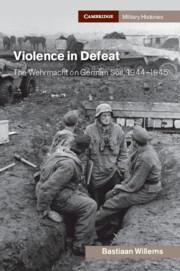Book contents
- Violence in Defeat
- Cambridge Military Histories
- Violence in Defeat
- Copyright page
- Contents
- Figures
- Maps
- Tables
- Acknowledgements
- Chronology of Events
- Abbreviations
- Introduction
- 1 Regionality and Total War in East Prussia
- 2 Eastern Front Battles on German Soil
- 3 The City As a Fortress Community
- 4 Redefining Königsberg: Historical Continuity in Practice
- 5 The Evacuation of East Prussia
- 6 Königsberg as a Community of Violence
- Conclusion
- Appendices
- Bibliography
- Index
6 - Königsberg as a Community of Violence
Published online by Cambridge University Press: 12 February 2021
- Violence in Defeat
- Cambridge Military Histories
- Violence in Defeat
- Copyright page
- Contents
- Figures
- Maps
- Tables
- Acknowledgements
- Chronology of Events
- Abbreviations
- Introduction
- 1 Regionality and Total War in East Prussia
- 2 Eastern Front Battles on German Soil
- 3 The City As a Fortress Community
- 4 Redefining Königsberg: Historical Continuity in Practice
- 5 The Evacuation of East Prussia
- 6 Königsberg as a Community of Violence
- Conclusion
- Appendices
- Bibliography
- Index
Summary
This chapter will further explore the consequences of the German troops’ contact with their compatriots. The failure to evacuate the local population from East Prussia meant that they found themselves in Königsberg, an area of operations under martial law where a military mindset prevailed. Soldiers perceived their environment completely differently than civilians and yet the set of military laws to which these men had long adhered became the standard of reference for what passed as ‘normality’. In this major shift in what was considered normal, almost from the very commencement of the siege of Königsberg civilians were ordered to contribute to its defence, thus having to ‘earn’ the right to be protected. In line with military custom, failure to comply was considered desertion and was punishable by death, even though commanders were fully aware that civilians could not accustom themselves to military standards overnight. Since these coercive measures ensured a compliant population, Party functionaries expressed the desire to implement similar legislation on a national level, which took place throughout February and March 1945. This led to a diverse set of perpetrators, which in turn resulted in a dramatic increase in the number of victims among the general population.
Keywords
- Type
- Chapter
- Information
- Violence in DefeatThe Wehrmacht on German Soil, 1944–1945, pp. 243 - 285Publisher: Cambridge University PressPrint publication year: 2021

